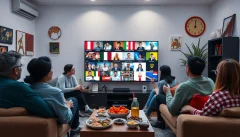In today’s digital age, screens work together to change how you watch. You watch a show as you scroll through social media or stream a movie while you work on your laptop. These devices join closely to give you a smooth, personal view. If you ask how to use screens well and improve your viewing habits, this multiscreen guide is here to help.
Understanding the Power of Multiscreen
The term multiscreen means using several electronic screens—smartphones, tablets, computers, and smart TVs—that let you see and use digital content one after another or at the same time. This system improves fun and work. It gives you ease and flexibility that a single screen cannot match.
Why is Multiscreen Important?
- Increased Involvement: Users stay more tied in when they switch between devices quickly.
- Better Work Capacity: Multiscreen setups let you handle tasks at once, such as reading on a tablet while you join a video call on your computer.
- Wider Media Access: Multiscreen use makes it simple to view many kinds of media, from streaming apps to social networks.
How Multiscreen Works
Screens work together when they sync. Devices talk with one another via Wi-Fi, Bluetooth, or special apps. They share data, show the same view, or even expand your display to keep things seamless.
Types of Multiscreen Configurations
-
Mirroring:
All screens show the same view at the same time. This setup works well in meetings and when you watch a show with family. -
Extended Displays:
Devices join to widen your workspace. Many use this for games or work tasks. -
Secondary Screen Use:
One device takes a side role. It can show your chat or notes while the main screen plays your content.
Benefits of a Well-Implemented Multiscreen Setup
- Task Switching: Swap between tasks quickly without the need to hide or close windows.
- Wide View: Enjoy a view that stretches or grows bigger because of many screens.
- Device Flexibility: Use different screens for different tasks to build a richer digital space.
Setting Up Your Multiscreen System Effectively
Achieving a good multiscreen experience involves some clear steps:
1. Assess Your Devices and Needs
Look at the screens you have and decide what you need. Do you want deep media fun, more work speed, or a good gaming setup? Your aim sets the next steps.
2. Ensure Compatibility and Connectivity
Check that your devices can work in a multiscreen way. Most modern gadgets support options like Miracast, AirPlay, or Chromecast. A strong Wi-Fi is a must for smooth sharing of content.

3. Choose the Right Apps and Software
Some apps help your multiscreen work:
- AirPlay (Apple devices): Send content from iOS devices to an Apple TV.
- Google Cast (Chromecast): Wirelessly send content from Chrome or supported apps.
- Duet Display or iDisplay: Extend your desktop to tablets or extra monitors.
- Splashtop or TeamViewer: Use remote desktop tools to control screens from afar.
4. Optimize Your Physical Setup
Place your screens so that they fit your eye level. Make sure your space has enough power outlets and that cables stay neat.
5. Test Your Setup and Fine-Tune
After you connect your devices, test how they work together. Adjust settings such as speed, picture clarity, or sound so that everything flows smoothly.
Top Tips for Improving Your Multiscreen Experience
- Use the same display settings on each device so that the images match.
- Activate auto-start or use key shortcuts for fast screen switching.
- Get a mount or stand that can hold multiple monitors safely.
- Keep firmware and software current for better safety and speed.
- Check the screen resolution and aspect ratio to match your media well.
Common Challenges and How to Overcome Them
Multiscreen setups can make your digital life better, but some issues may come up:
- Delay Problems: Use wired connections where you can or upgrade your Wi-Fi router.
- Device Mismatch: Check your device details before you connect them.
- Display Differences: Change screen resolution settings so that all views match.
- Hardware Limits: A newer graphics card or extra adapters might be needed to run things smoothly.
The Future of Multiscreen Technology
Tech moves fast. Multiscreen systems will grow smarter and work as one. New features like foldable screens, very high resolution visuals, and smart tools for content will change how you use devices. Experts expect multiscreen use to grow a lot with more remote work and time spent with media (source).
FAQ About Multiscreen
Q1: What is the best multiscreen setup for a home entertainment system?
A1: For a strong home experience, use a large 4K smart TV with a streaming device or computer that can send content to extra screens. Adding a tablet or second monitor for browsing or handling tasks can improve your view.
Q2: How can I improve my multiscreen experience for remote work?
A2: Use multiple monitors or tablets as extra screens. Keep your chat windows, reference files, or apps open together. This setup helps you work more smoothly while keeping your windows in order.
Q3: Are there any security issues with multiscreen setups?
A3: Yes. When you share content over Wi-Fi, secure your network with strong passwords and use trusted apps to keep your data safe.
Conclusion: Use All That Multiscreen Can Do
Using multiscreen tech changes how you work with digital media. If you wish to set up a broad view for movies, work, or gaming, a good multiscreen system makes it possible. Check your devices, choose the right tools, and set up your space well. Use multiscreen to improve your digital life and enjoy media as it should be seen. Start now and step into a smarter, more efficient view.


